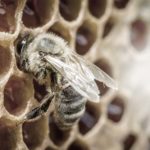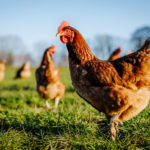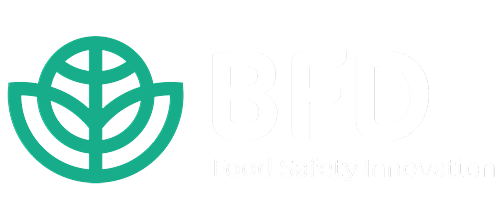
Starters & Appetisers: Day 3 – 12 Days of Food Safety
Starters & Appetisers: Day 3
12 Days of Food Safety
Bread often accompanies many starters and appetisers at this time of year and can add a wonderful touch to your holiday gathering, offering a range of flavours and textures that are sure to be enjoyed by your guests. Below are a few examples of starters and appetisers ideas using bread that are perfect for the festive season:
- Cranberry and Brie Crostini is a scrumptious appetiser that combines the creamy richness of brie with the sweet-tart flavour of cranberry sauce on toasted baguette slices.
- Pull Apart Bread with Camembert is delicious and indulgent dish, perfect for sharing as an appetiser or part of the festive spread. Shape into a Christmas tree for a delightful and visually appealing addition to your holiday table.
- Sausage Roll Wreath is a fantastic way to bring a festive theme to the appetiser table. It’s a great sharing dish for the holiday season.
- Soup with bread is a common starter enjoyed by many throughout the holiday season, whether the traditional vegetable soup or a delicious festive Butternut Squash and Apple Soup.
- Bread shrimp can make a tasty starter or appetiser throughout the holiday season, served with a dipping sauce of choice.
Bread Production
There are various grains utilised in the production of bread. The choice of grains imparts different flavours, textures, and nutritional profiles to the bread. Some of these grains include 1:
- Corn flour or cornmeal is utilised in the production of cornbread or cornmeal bread, which has a slightly sweet, but dense flavour.
- Wheat is the most widely utilised grain in bread production. Wheat contains gluten which is a protein that gives bread its structure and elasticity.
- Quinoa is a less common flour utilised in the production of bread, but it is used in gluten-free or alternative grain bread. Quinoa adds a unique texture and nutritional value.
- Buckwheat is not related to wheat despite its name. Buckwheat is gluten-free and makes a great alternative for gluten-free bread.
- Oats can be used in whole form, as oat flour, or as oat bran in bread. Oat bread is known for its nutty flavour and hearty texture.
The combination of these grains, along with different processing techniques, contributes to a wide variety of bread available worldwide. It’s worth noting that gluten-free bread options often rely on alternative grains to wheat, such as rice flour, sorghum flour, and a variety of starches 1.
Mycotoxins in Bread
Mycotoxins are naturally occurring toxic compounds produced by different types of fungi. Mycotoxins enter the food chain through the infection of crops either before or after harvest and are typically found in cereals, dried fruits, nuts and spices 2.
Cereal grains are the most important food staple for humans and livestock. Cereal grains are processed into various food and feed products, including bread, pasta, cake, snacks, pet food and more. The presence of mycotoxins in bread is a result of the grains utilised in the production of bread become contaminated with mould before or during harvest, when in storage or during the processing of the grains 3.
Deoxynivalenol (DON)
Several mycotoxins affect cereal grains, all of which are produced from different types of fungi. Mycotoxin contamination of cereal grains remains the main food safety issue 3.
Deoxynivalenol (DON) or vomitoxin (a name given due to its emetic effects), is the most prevalent mycotoxin in foods of plant origin (cereal grains, such as barley, corn, oats, rice, wheat, and other grains in the field or during storage 3, 4, 5. DON is produced by the Fusarium fungi, a fungi responsible for Gibberella ear rot on corn and Fusarium head blight in small grains (head scab) 3. When the fungus infects different parts of the plant, mycotoxins are produced which remain in the affected tissues, even when the fungus spreads to other tissues or dies. DON production aids the fungus in spreading through the plant. As such, DON contamination occurs while the crops are still in the field and can continue to increase if storage conditions are substandard and favours fungal growth 5.
DON is a heat-stable mycotoxin and can withstand temperatures that are commonly used for food and feed processing and ethanol production 6.
DON Toxicity
DON contamination has been reported in grains on a global scale. Regions with temperate climates, where Fusarium species thrive, are particularly susceptible. This includes areas in North America, Europe, Asia, and parts of South America 5.
The toxic effects of DON are the result of the free hydroxyl (OH) groups and the epoxide ring (a common feature in all trichothecenes). DON toxicity only occurs following the ingestion of contaminated foods. The most common toxic effect of DON is the inhibition of mitochondrial function and protein synthesis, which particularly affects fast growing cells. DON causes immunomodulation and immunosuppression and cytotoxic effects. Examples of other effects include: destruction of bone marrow, gastroenteritis, impairment of gut integrity and intestinal bleeding 5. Throughout the years, there have been a few outbreaks of DON.
- A study was conducted between 2010 and 2019 by scientists from the University of Bath and the University of Exeter which looked at the Fusarium head blight (FHB). The study found that half of the wheat that was intended for human food in Europe contained DON, with 70% in the UK was contaminated. Nonetheless 95% met the safety limits for DON 7.
- A systemic review and meta-analysis of the prevalence and concentrations of DON in cereal-based products in Spain (grain, milled cereals, bred and derived products, pasta and derived products, breakfast cereals, salty snacks and baby food) was conducted for the first time through the retrieval of studies published within the last 15 years. The highest prevalence %TDI values ranging from 12% to 34% was observed in bread and derivatives 8.
DON Management
As the presence of mycotoxins in food cannot be completely avoided, it is essential to ensure that controls are in place to ensure that the exposure of mycotoxins in food is as low as possible. These controls range from ensuring that good practice is adhered to during growing, harvesting and storage of grains/foods as well as establishing the maximum levels when necessary 9.
For consumer safety, strict rules and regulations have been put in place for Mycotoxins. Mycotoxins are not evenly distributed throughout the food and as such, Mycotoxins occur in hotspots. To ensure that test samples are representative of the entire food batch, provisions for sampling and analysis for the office control of maximum levels for mycotoxins were created. The provisions for sampling and analysis are applicable for enforcement bodies only, however, it is vital for food business operators to be aware of these provisions when carrying out due diligence checks 9.
The contamination control of DON is vital in the mitigation of economic losses and improving the safety of food in the food safety chain. Some effective measures have been actioned to control DON contamination in grain production. Such measures include: application of fungicides, biological control agents (BCAs), crop rotation, and the selection of resistant wheat lines 10.
Each territory have established their own rules and regulations for mycotoxin control. Below is a breakdown of DON maximum levels by territory.
| Table 1: Europe (DON) – European Commission 11 | ||
| Code | Commodity | Limit (ppb) |
| 1.1 | Unprocessed cereals other than durum wheat, oats and maize | 1,250 |
| 1.2 | Unprocessed durum wheat and oats | 1,750 |
| 1.3 | Unprocessed maize, with the exception of unprocessed maize intended to be processed by wet milling | 1,750 |
| 1.4 | Cereals intended for direct human consumption, cereal flour, bran and germ as end product marketed for direct human consumption, with the exception of foodstuffs listed in 1.7, 1.8 and 1.9 | 750 |
| 1.5 | Pasta (dry) | 750 |
| 1.6 | Bread (including small bakery wares), pastries, biscuits, cereal snacks and breakfast cereals | 500 |
| 1.7 | Processed cereal-based foods and baby foods for infants and young children | 200 |
| 1.8 | Milling fractions of maize with particle size > 500 micron falling within CN code 1103 13 or 1103 20 40 and other maize milling products with particle size > 500 micron not used for direct human consumption falling within CN code 1904 10 10 | 750 |
| 1.9 | Milling fractions of maize with particle size ≤ 500 micron falling within CN code 1102 20 and other maize milling products with particle size ≤ 500 micron not used for direct human consumption falling within CN code 1904 10 10 | 1,250 |
| Table 2: America (DON) FDA Regulations 12 | ||
| Intended Use | Grain or Grain By-Products | Limit (ppm) |
| Human Consumption | Finished wheat products | 1ppm |
| Swine | Grain and grain by-products not to exceed 20% of diet | 5ppm
1ppm** |
| Chickens | Grain and grain by-products not to exceed 50% of diet | 10ppm
5ppm** |
| Ruminating beef and feedlot cattle older than 4 months | Grain and grain by-products* | 10ppm
10ppm** |
| Ruminating dairy cattle older than 4 months | Grain and grain by-products not to exceed 50% of diet* | 10ppm
5ppm** |
| Ruminating beef and feedlot cattle older than 4 months, and ruminating dairy cattle older than 4 months | Distiller grains, brewers grains, gluten feeds, and gluten meals* | 30ppm
10ppm beef/feedlot** 5ppm dairy** |
| All other animals | Grain and grain by-products not to exceed 40% of diet | 5ppm
2ppm** |
| *88 percent dry matter basis **Complete diet figures shown within parentheses | ||
BFD Testing Panel
Biorex Food Diagnostics provides an immunoassay-based test designed to detect Deoxynivalenol (DON) along with its primary metabolites, 3-acetyl-DON and 3-glucosyl-DON. Notably, the test exhibits minimal cross-reactivity with 15-acetyl-DON and Nivalenol, underscoring the exceptional specificity of the antibody employed in developing this kit. The rapid 20-minute testing process involves straightforward sample preparation and offers outstanding sensitivity, effortlessly meeting industry regulations and standards.
| Table 3: BFD DON ELISA Ordering Information | ||||
| Cat. No. | Assay Time | Specificity | Sample Types | LoD (ppb) |
| BXEFT18A | 20 mins | 3-acetyl-DON >100%
DON 100% 3-glucosyl-DON 60 ± 10% 15-acetyl-DON 2%
|
Cereals (maize/wheat)
Feed Durum Wheat Barley Wheat Bran/Middlings |
0.04ppm
0.04ppm 0.12ppm 0.04ppb 0.25ppb |
If you wish to learn more about the Biorex Fod Diagnostics DON ELISA kit please don’t hesitate to contact us.
Have you missed the previous 12 Days of Food Safety? Not to worry. Click the image below to check it out.
References
- Unlock Food. All About Grain Flours. https://www.unlockfood.ca/en/Articles/Cooking-And-Food/Grain-Products/All-about-grain-flours.aspx# (accessed 24 November 2023).
- Mycotoxins. https://www.efsa.europa.eu/en/topics/topic/mycotoxins (accessed 24 November 2023).
- Yu J, Pedroso IR. Mycotoxins in Cereal-Based Products and Their Impacts on the Health of Humans, Livestock Animals and Pets. Toxins (Basel) 2023; 15(8): . https://www.ncbi.nlm.nih.gov/pmc/articles/PMC10467131/ (accessed 24 November 2023).
- Sobrova P, Adam V, Vasatkova A, Beklova M, Zeman L, et al. Deoxynivalenol and its toxicity. Interdisciplinary Toxicity 2010; 3(3): . https://www.ncbi.nlm.nih.gov/pmc/articles/PMC2984136/#:~:text=Deoxynivalenol%20(DON)%20is%20one%20of,the%20field%20or%20during%20storage. (accessed 24 November 2023).
- info. Deoxynivalenol. https://www.mycotoxins.info/mycotoxins/deoxynivalenol/ (accessed 24 November 2023).
- Murillo- Williams A, Collins A, Esker PD. From Aflatoxin to Zearalenone: Mycotoxins You Should Know – Deoxynivalenol (DON). https://extension.psu.edu/from-aflatoxin-to-zearalenone-mycotoxins-you-should-know-deoxynivalenol-don (accessed 24 November 2023).
- News Desk. Scientists expose the scale of mycotoxins in wheat problem. https://www.foodsafetynews.com/2022/12/scientists-expose-scale-of-mycotoxins-in-wheat-problem/ (accessed 24 November 2023).
- Narváez A, Castaldo L, Izzo L, Pallarés N, Rodríguez-Carrasco Y, et al. Deoxynivalenol contamination in cereal-based foodstuffs from Spain: Systematic review and meta-analysis approach for exposure assessment. Food Control 2022; 132(108521): . https://www.sciencedirect.com/science/article/abs/pii/S0956713521006599 (accessed 24 November 2023).
- Food Standards Agency. https://www.food.gov.uk/business-guidance/mycotoxins (accessed 27 November 2023).
- Tian Y, Tan Y, Liu N, Liao Y, Sun C, et al. Functional Agents to Biologically Control Deoxynivalenol Contamination in Cereal Grains. Frontiers in Microbiology 2016; 7(): . https://www.frontiersin.org/articles/10.3389/fmicb.2016.00395/full (accessed 24 November 2023).
- European Union Law. Commission Regulation (EC) No 1126/2007 of 28 September 2007 amending Regulation (EC) No 1881/2006 setting maximum levels for certain contaminants in foodstuffs as regards Fusarium toxins in maize and maize products (Text with EEA relevance). https://eur-lex.europa.eu/legal-content/EN/TXT/?uri=celex%3A32007R1126 (accessed 27 November 2023).
- FDA Mycotoxin Regulator Guidance: A Guide for Grain Elevators, Feed Manufacturers, Grain Processors and Exporters. https://www.aflatoxinpartnership.org/wp-content/uploads/2021/05/NGFAComplianceGuide-FDARegulatoryGuidanceforMycotoxins8-2011.pdf (accessed 27 November 2023).









